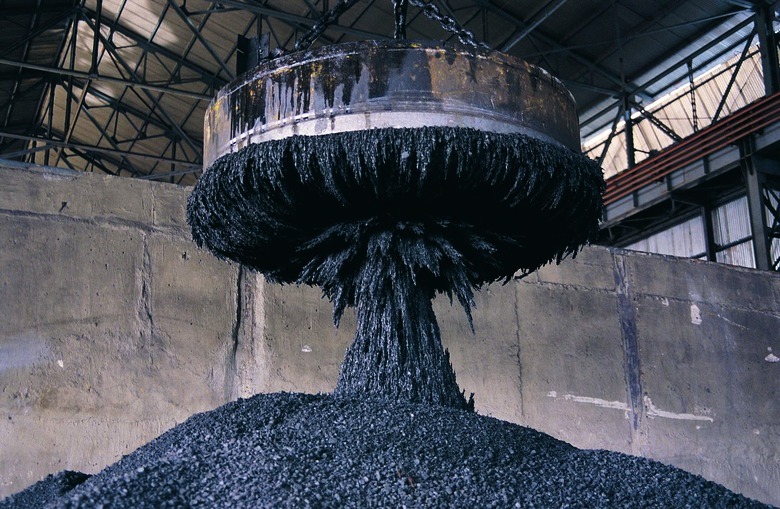How To Extract Iron From Sand
Approximately a third of the Earth's crust consists of iron, which the main ingredient used to make steel. In nature, it exists as an ore, and steel manufacturers must extract it before they can use it. One such ore is a type of iron oxide called titanomagnetite, which is formed as volcanic lava crystallizes. Rivers and streams wash this to the sea, and most of it ends up as "black sand" on ocean beaches everywhere, but mostly in New Zealand and California. Because iron is strongly magnetic, you can extract it from any type of beach sand with a magnet.
Step 1
Construct a drum magnet, which offers a more efficient way to extract a large volume of iron than passing a flat magnet over the sand. To construct the magnet, you'll need a length of 4-inch PVC pipe, some permanent magnets and some two-part epoxy cement.
Step 2
Cut the 4-inch pipe to a length of about 12 inches using a hacksaw. Glue eight 1/2-inch cylindrical neodymium magnets to the inside of the pipe with epoxy cement, spacing them as evenly around the inside of the pipe as you can.
Step 3
Check the polarity of each magnet before gluing it — all magnets must be glued to the pipe with the same pole facing out. To check polarity, bring one magnet close to one that's already glued. If you feel a repelling force, turn the magnet around before gluing it. If you feel an attractive force, glue the magnet in that orientation.
Step 4
Allow the glue to set until it's hard, then glue a PVC cap onto each end of the pipe using PVC cement. Drill a 1/2-inch hole through the center of each cap and pass a 1/2-inch wooden dowel through the drum so that it extends out from 4 to 6 inches on either side. Drill a 1/4-inch hole through one end and pass through a small length of 1/4-inch dowel to use as a handle for turning the drum.
Step 5
Build a shallow tray out of plywood that has two sections separated by a wooden divider. Construct a holder out of plywood that will suspend the drum over one of the sections and about 2 inches from the divider. The holder needs to consist of two upward-facing forks that can support the dowel — much like a rotisserie.
Step 6
Suspend the drum in the holder and staple a piece of rigid but flexible plastic to the divider. The plastic should be long enough to rest securely on the surface of the drum, and it should be wide enough to cover the space between the end caps.
Step 7
Begin rotating the drum so that the top is moving toward the plastic. Pour sand slowly on the opposite side of the drum while you turn it. The magnets will attract the iron filings onto the drum while the rest of the sand continues falling. When the filings reach the plastic, it will scrape them off the drum and they'll collect on the other side of the divider.
Things Needed
- 4-inch PVC pipe
- Eight 1/2-inch cylindrical neodymium magnets
- Hacksaw
- 2-part epoxy cement
- Two 4-inch PVC end caps
- PVC pipe cement
- Drill
- 1/2- and 1/4-inch drill bits
- 1/2- and 1/4-inch wood dowels
- Plywood
- Rigid but flexible plastic
- Staples
TL;DR (Too Long; Didn't Read)
Collect the sand you've poured after enough has collected and pour it again. You probably won't remove all the iron in the first pouring.
The iron you extract will still be mixed with impurities. In a commercial operation, the first extraction would be ground and passed through another, more sensitive extractor with weaker magnets that don't attract semi-magnetic materials.
Warning
Neodymium magnets have a powerful magnetic pull and must be handled with care. If you bring two of them close enough together, your finger can get pinched between them.
Cite This Article
MLA
Deziel, Chris. "How To Extract Iron From Sand" sciencing.com, https://www.sciencing.com/extract-iron-from-sand-2340112/. 24 April 2017.
APA
Deziel, Chris. (2017, April 24). How To Extract Iron From Sand. sciencing.com. Retrieved from https://www.sciencing.com/extract-iron-from-sand-2340112/
Chicago
Deziel, Chris. How To Extract Iron From Sand last modified March 24, 2022. https://www.sciencing.com/extract-iron-from-sand-2340112/
